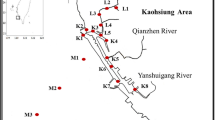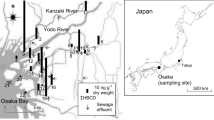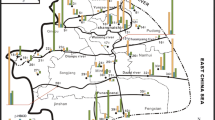Abstract
The occurrence and health risk of hexabromocyclododecane (HBCD), a brominated flame retardant with its three diastereoisomers, in drinking water sources in the lower Yangtze River in China was investigated. Its concentration ranged from 0.58 to 3.71 ng/L and averaged at 1.18 ng/L. Among the three diastereoisomers of α-, β- and γ-HBCD, γ-HBCD was the dominant one accounting for 44% (ranging 27–82%) to the total concentration. Source of HBCD in the contaminated site was discussed according to its spatial distribution and diastereoisomer profile. The margin of exposure (MOE) approach was applied to evaluate the health risk of HBCD through drinking water by estimated exposure and derived reference dose. The MOE was 17 for adults and 12 for children in the worst-case scenario, suggesting a trivial health concern.



Similar content being viewed by others
References
Borg D, Lund B-O, Lindquist N-G, Håkansson H (2013) Cumulative health risk assessment of 17 perfluoroalkylated and polyfluoroalkylated substances (PFASs) in the Swedish population. Environ Int 59:112–123
Chen H, Guo S, Li H, Zhou D, Cao X, Wang C, Liu Y, Xiang M, Li L, Yu Y (2019) Multi-generational effects and variations of stress response by hexabromocyclododecane (HBCD) exposure in the nematode Caenorhabditis elegans. J Environ Manage 245:216–222
Eljarrat E, Guerra P, Martínez E, Farré M, Alvarez JG, López-Teijón M, Barceló D (2009) Hexabromocyclododecane in human breast milk: levels and enantiomeric patterns. Environ Sci Technol 43:1940–1946
Eljarrat E, Gorga M, Gasser M, Díaz-Ferrero J, Barceló D (2014) Dietary exposure assessment of Spanish citizens to hexabromocyclododecane through the diet. J Agric Food Chem 62:2462–2468
Guo X, Feng C, Gu E, Tian C, Shen Z (2019) Spatial distribution, source apportionment and risk assessment of antibiotics in the surface water and sediments of the Yangtze Estuary. Sci Total Environ 671:548–557
Harrad S, Abdallah MA-E, Covaci A (2009a) Causes of variability in concentrations and diastereomer patterns of hexabromocyclododecanes in indoor dust. Environ Int 35:573–579
Harrad S, Abdallah MA-E, Rose NL, Turner SD, Davidson TA (2009b) Current-use brominated flame retardants in water, sediment, and fish from English lakes. Environ Sci Technol 43:9077–9083
He M-J, Luo X-J, Yu L-H, Wu J-P, Chen S-J, Mai B-X (2013) Diasteroisomer and enantiomer-specific profiles of hexabromocyclododecane and tetrabromobisphenol A in an aquatic environment in a highly industrialized area, South China: vertical profile, phase partition, and bioaccumulation. Environ Pollut 179:105–110
Heeb NV, Schweizer WB, Kohler M, Gerecke AC (2005) Structure elucidation of hexabromocyclododecanes—a class of compounds with a complex stereochemistry. Chemosphere 61:65–73
Kajiwara N, Takigami H (2013) Emission behavior of hexabromocyclododecanes and polybrominated diphenyl ethers from flame-retardant-treated textiles. Environ Sci Process Impacts 15:1957–1963
Li H, Zhang Z, Sun Y, Wang W, Xie J, Xie C, Hu Y, Gao Y, Xu X, Luo X, Mai B (2021) Tetrabromobisphenol A and hexabromocyclododecanes in sediments and biota from two typical mangrove wetlands of South China: distribution, bioaccumulation and biomagnification. Sci Total Environ 750:141695
Lu H, Ma X-J, Huang X-J, Lu S, Huang Y-H, Mo C-H, Cai Q-Y, Wong M-H (2019) Distribution, diastereomer-specific accumulation and associated health risks of hexabromocyclododecanes (HBCDs) in soil-vegetable system of the Pearl River Delta region, South China. J Environ Manag 248:109321
MEE China (2013) Exposure factors handbook of Chinese population. Ministry of Ecology and Environment of China, Beijing
MEE China (2017) Technical guideline for deriving water quality criteria for the protection of human health. HJ 837–2017.
Miller I, Serchi T, Cambier S, Diepenbroek C, Renaut J, Van der Berg JHJ, Kwadijk C, Gutleb AC, Rijntjes E, Murk AJ (2016) Hexabromocyclododecane (HBCD) induced changes in the liver proteome of eu- and hypothyroid female rats. Toxicol Lett 245:40–51
Miller-Rhodes P, Popescu M, Goeke C, Tirabassi T, Johnson L, Markowski VP (2014) Prenatal exposure to the brominated flame retardant hexabromocyclododecane (HBCD) impairs measures of sustained attention and increases age-related morbidity in the Long-Evans rat. Neurotoxicol Teratol 45:34–43
Oh JK, Kotani K, Managaki S, Masunaga S (2014) Levels and distribution of hexabromocyclododecane and its lower brominated derivative in Japanese riverine environment. Chemosphere 109:157–163
POPRC (2010) Report of the Persistent Organic Pollutants Review Committee on the work of its sixth meeting: risk profile on hexabromocyclododecane. UNEP/POPS/POPRC.6/13/Add.2.
POPRC. 2012a. Report of the Persistent Organic Pollutants Review Committee on the work of its eighth meeting: addendum to the risk management evaluation on hexabromocyclododecane. UNEP/POPS/POPRC.8/16/Add.3.
POPRC. 2012b. SC-6/13: listing of hexabromocyclododecane.
Rani M, Shim WJ, Han GM, Jang M, Song YK, Hong SH (2014) Hexabromocyclododecane in polystyrene based consumer products: an evidence of unregulated use. Chemosphere 110:111–119
Rasinger JD, Carroll TS, Lundebye AK, Hogstrand C (2014) Cross-omics gene and protein expression profiling in juvenile female mice highlights disruption of calcium and zinc signalling in the brain following dietary exposure to CB-153, BDE-47, HBCD or TCDD. Toxicology 321:1–12
Rodrigo G, Jaccard G, Tafin Djoko D, Korneliou A, Esposito M, Belushkin M (2021) Cancer potencies and margin of exposure used for comparative risk assessment of heated tobacco products and electronic cigarettes aerosols with cigarette smoke. Arch Toxicol 95:283–298
Ruan Y, Zhang K, Lam JCW, Wu R, Lam PKS (2019) Stereoisomer-specific occurrence, distribution, and fate of chiral brominated flame retardants in different wastewater treatment systems in Hong Kong. J Hazard Mater 374:211–218
Saegusa Y, Fujimoto H, Woo G-H, Inoue K, Takahashi M, Mitsumori K, Hirose M, Nishikawa A, Shibutani M (2009) Developmental toxicity of brominated flame retardants, tetrabromobisphenol A and 1,2,5,6,9,10-hexabromocyclododecane, in rat offspring after maternal exposure from mid-gestation through lactation. Reprod Toxicol 28:456–467
Saegusa Y, Fujimoto H, Woo G-H, Ohishi T, Wang L, Mitsumori K, Nishikawa A, Shibutani M (2012) Transient aberration of neuronal development in the hippocampal dentate gyrus after developmental exposure to brominated flame retardants in rats. Arch Toxicol 86:1431–1442
Schreder ED, La Guardia MJ (2014) Flame retardant transfers from U.S. Households (dust and laundry wastewater) to the aquatic environment. Environ Sci Technol 48:11575–11583
Shi Z, Zhang L, Zhao Y, Sun Z, Zhou X, Li J, Wu Y (2017) Dietary exposure assessment of Chinese population to tetrabromobisphenol-A, hexabromocyclododecane and decabrominated diphenyl ether: results of the 5th Chinese total diet study. Environ Pollut 229:539–547
Thompson CM, Kirman CR, Hays SM, Suh M, Harvey SE, Proctor DM, Rager JE, Haws LC, Harris MA (2018) Integration of mechanistic and pharmacokinetic information to derive oral reference dose and margin-of-exposure values for hexavalent chromium. J Appl Toxicol 38:351–365
Valenzuela-Sánchez IS, Zapata-Pérez O, Garza-Gisholt E, Gold-Bouchot G, Barrientos-Medina RC, Hernández-Núñez E (2019) Polybrominated diphenyl ethers (PBDE) and hexabromocyclododecane (HBCD) in liver of checkered puffer (Sphoeroides testudineus) from Ria Lagartos, Yucatan, Mexico. Mar Pollut Bull 146:488–492
Xu J, Zhang Y, Guo C, He Y, Li L, Meng W (2013) Levels and distribution of tetrabromobisphenol A and hexabromocyclododecane in Taihu Lake, China. Environ Toxicol Chem 32:2249–2255
Xu C, Chen L, You L, Xu Z, Ren LF, Yew-Hoong Gin K, He Y, Kai W (2018) Occurrence, impact variables and potential risk of PPCPs and pesticides in a drinking water reservoir and related drinking water treatment plants in the Yangtze Estuary. Environ Sci Process Impacts 20:1030–1045
Yanagisawa R, Koike E, Win-Shwe T-T, Yamamoto M, Takano H (2014) Impaired lipid and glucose homeostasis in hexabromocyclododecane-exposed mice fed a high-fat diet. Environ Health Perspect 122:277–283
Yang C, Abdallah MA-E, Desborough J, Burniston D, Tomy G, Harrad S, Marvin C (2019) Trends in hexabromocyclododecanes in the UK and North America. Sci Total Environ 658:861–867
Zhang Y, Li Q, Lu Y, Jones K, Sweetman AJ (2016) Hexabromocyclododecanes (HBCDDs) in surface soils from coastal cities in North China: correlation between diastereoisomer profiles and industrial activities. Chemosphere 148:504–510
Zhang Y, Lu Y, Wang P, Li Q, Zhang M, Johnson AC (2018a) Transport of Hexabromocyclododecane (HBCD) into the soil, water and sediment from a large producer in China. Sci Total Environ 610–611:94–100
Zhang Y, Lu Y, Wang P, Shi Y (2018b) Biomagnification of Hexabromocyclododecane (HBCD) in a coastal ecosystem near a large producer in China: human exposure implication through food web transfer. Sci Total Environ 624:1213–1220
Acknowledgements
The study was supported by Central Public-interest Scientific Institution Basal Research Fund of China (GYZX210502 and GYZX200204); the Environment Protection Research Program of Jiangsu Province, China (2017024).
Author information
Authors and Affiliations
Corresponding author
Additional information
Publisher's Note
Springer Nature remains neutral with regard to jurisdictional claims in published maps and institutional affiliations.
Rights and permissions
About this article
Cite this article
Zhang, Y., Baninla, Y., Yu, J. et al. Occurrence, Spatial Distribution and Health Risk of Hexabromocyclododecane (HBCD) in Source Water in the Lower Yangtze River, China. Bull Environ Contam Toxicol 109, 943–948 (2022). https://doi.org/10.1007/s00128-021-03431-0
Received:
Accepted:
Published:
Issue Date:
DOI: https://doi.org/10.1007/s00128-021-03431-0




